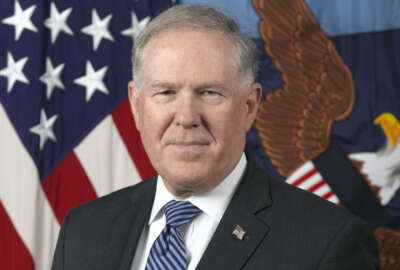Hubbard Radio Washington DC, LLC. All rights reserved. This website is not intended for users located within the European Economic Area.
Waste, fraud in Iraq put all eyes on DoD contracting
When the Defense Department began contingency contracting operations on a large-scale in Iraq in 2003 it was largely a trial by fire. Despite the best planni...
wfedstaff | April 17, 2015 3:48 pm
The Commission on Wartime Contracting closed shop last August after two years investigating overseas contingency contracting in Iraq and Afghanistan. The commission’s final report declared between $30 billion and $60 billion lost to waste and fraud and sounded alarms about, what it called, the inadequate acquisition workforces at the Departments of Defense and State.
A few years earlier, when former Undersecretary of Defense Jacques Gansler was tasked with examining deficiencies in Army contracting, a general officer told the Gansler Commission shortcomings were “pervasive” across DoD: “Workload continues to go up while contracting and acquisition assets go down.”
While fraud and misconduct get plenty of play in the news media, experts say the biggest drain on funds in overseas contingency contracting stems not from fraud but from waste, poor planning, sparse resources and lax oversight — issues that plague nearly all of federal procurement.
|
“Unless you make the kinds of changes that are bureaucratically rock-solid, then things just fade away over time. And we’ll wind up making the same mistakes over and over.” — Dov Zakheim
|
Implementing true reforms to contingency contracting, while only a relatively small slice of the billions of dollars in federal buying, could enhance the entire acquisition process, advocates of reform suggest.
“Unless you make the kinds of changes that are bureaucratically rock-solid, then things just fade away over time,” said Dov Zakheim, a former member of the commission and a high- ranking Defense official in both the Reagan and George W. Bush administrations. “And we’ll wind up making the same mistakes over and over.”
Zakheim spoke to Federal News Radio as part of Federal News Radio’s special report, Trial by Fire: Overseas Contracting in Transition, part of the series, Inside the World’s Biggest Buyer.
Rethinking the force
DoD insists it has recast the entire philosophy behind its military force and capabilities.
Thirty years ago, the term “total force” simply meant the combined number of active and reserve military members. It now refers to military forces, DoD civilians and the contractors.
The more expansive definition recognizes the relationship between DoD personnel and contractors that work together in a contingency environment.
“I’m responsible for their care and feeding; I’m responsible for their housing; I’m responsible for their force protection,” said Gary Motsek, the deputy assistant secretary of defense for program support. “And they are responsible to me to accomplish their mission if I’m the ground-pounder down there,” he said, using a slang term for Army troops. “So, it’s a different mindset.”
Along with the newfound inclusiveness toward contractors, DoD recognized they couldn’t be managed from afar.
“It was an effort we thought we could manage remotely, even though we were spending billions and billions of dollars down-range,” Motsek said. “We thought we could manage this entire complex package remotely and we could not.”
The 2007 Gansler Commission also pointed to the importance of moving contracting officers and staff closer to the frontlines. Contracting personnel on the ground are better able to “interface and interact with their customer: the warfighter,” the commission stated in its report — as opposed to officials 12 time zones away.
Alan Chvotkin, executive vice president and counsel for the Professional Services Council, an industry association, said moving contracting staff forward helped minimize a communications gap that beleaguered the early days of reconstruction.
“They were literally handing out requirements without the coordination of the government,” Chvotkin said.
Contractors would be tasked with building a hospital before they had any knowledge of how the building would be wired for electricity. The end result was a completely finished, albeit useless, hospital.
Motsek acknowledged the early days of contingency contracting in Iraq and Afghanistan were akin to a “pick-up game.” DoD lacked the programs and practical solutions to handle the environment, he said.
But Motsek’s office is a testament to how far the department has come, he said. In 2006, DoD created the Office of Program Support to “orchestrate, synchronize and integrate” contingency acquisition planning.
“We try to look at this from a program-management portfolio as opposed to individual stovepipes,” Motsek said. “That’s probably one of the biggest lessons learned that we’re struggling through right now. You can’t manage individual contract vehicles; you’ve got to look at the whole of the effort.”
Less clear is what happens now, with the exit of military troops in Iraq and the transition to a diplomatic mission. The State Department and the United States Agency for International Development, the two main inheritors of DoD’s legacy, have not had comparable experiences in contingency contracting. Nor, many critics contend, have they learned from DoD’s past mistakes.
Oversight takes page from past

In March 1943, two years before becoming President, Harry Truman’s portrait graced the cover of Time magazine above the headline “Investigator Truman.” Then a Missouri senator, Truman led the Special Committee to Investigate the National Defense Program, which became famous for delving into the mismanagement of World War II defense contracts. It saved the government as much as $15 billion and launched Truman onto the national stage.
The Truman Committee became a blueprint of sorts for congressional oversight of the defense industry during wartime. When Sens. Claire McCaskill (D-Mo.) and Jim Webb (D-Va.) drew up language in 2007 to create an independent panel to review reconstruction efforts — the Commission on Wartime Contracting — they modeled it on Truman’s effort.
“We need a new investigatory body, inspired by the Truman Committee, to protect our tax dollars and bring better accountability to the way we do business while at war,” McCaskill said at the time.
The commission’s final report listed 15 broad recommendations to reform overseas contingency contracting. They included: expanding the roles of contingency contracting officials at DoD and State, developing better policies for managing private-security contractors and, perhaps most important, boosting much-needed on- the-ground oversight.
While special inspectors general have done admirable work in Iraq and Afghanistan, their agendas already are over-burdened, said Rep. John Tierney (D-Mass.), who helped write legislation in the House that created the commission.
The solution, he said, is the creation of a permanent IG for contingency operations, which the commission recommended. Shortly after the panel was shuttered, he introduced legislation to create the post.
The office would help “keep waste, fraud and abuse down in any wartime contracting situation,” Tierney said. “We have the expertise that continues so that we know as one contingency operation to another, we take the best practices we learned … and put those to the best use.”
Both DoD and State opposed the creation of the special IG when it appeared as a commission recommendation. Tierney’s bill has been introduced in committee but has not yet advanced.
By the book: Teaching contingency contracting
Observers remain worried that lessons learned and reforms enacted remain fragile. The commission warned improvements “are in danger of atrophy” especially once operations in Iraq and Afghanistan wind down.
To combat this, DoD has beefed up the training offered to contracting officers involved in operational contract support.
The Defense Acquisition University also is pursuing a number of training tools and methods to inculcate best practices before contracting officers ever step foot on forward-operating bases.
Every year since 1995, DAU has offered at least one course dedicated to contingency contracting.
“We realized, as a military, we were going to have many more joint operations,” said Harold McAlduff, performance learning director for contingency contracting at the Defense Acquisition University. “So the doctrine was striving to do things in a joint manner.” But there’s still a ways to go. Often, the services “don’t even talk the same language, even if they’re in the same career field,” he added.
In 2008, following the release of a new guide, the “Defense Contingency Contracting Handbook,” DAU’s course was overhauled to emphasize up-to-date training inspired by on-the-ground events.
“What separates contingency contracting from your normal, day-to-day, run-of-the- mill garrison-type contracting? The biggest thing is the compression of time — the ops tempo,” McAlduff said. Unlike day-to-day buying stateside, requirements not only impact property but often lives.
Also, contingency contracting officers (CCOs), must be adept at buying a variety of goods and services.

“Because of the footprint required of the forces, you really become a jack-of-all- trades,” McAlduff said. “You’re not just buying the same thing over and over again. You might be working on a construction contract today, an IT contract later this afternoon and a services contract at midnight.”
Along with creating a special contingency IG, Tierney’s bill also would set up a Center for Contingency Contracting to act as a repository for best practices.
“It’s nice to teach a course on (contracting), but we have to take those lessons and be able to make sure that we learn from them and that we don’t keep recreating those situations that we found in Iraq and Afghanistan because it’s billions of dollars,” Tierney said.
The center would retain only a skeleton presence if the U.S. were not formally engaged in a contingency operation, but would remain a resource for agencies and Congress.
‘The next one’
DoD’s Office of Program Support, which has evolved in its mission over the past six years, now is focused on staying ahead of the curve.
“We’ve been clearly reactive over the last several years in trying to put out the fires that have been raised by Congress, by commissions, by other studies and the like,” Motsek said. The focus is now on what DoD calls “the next one.”
“Let’s build the systems, let’s build the programs, let’s build the practical solutions,” Motsek said, so DoD can head into the next contingency environment fully prepared to manage all elements of the force.
On that at least, the wartime contracting commission clearly agreed, intoning in its final report: “There will be a next contingency.”
While the situation on the ground is very different compared to Iraq, the recently announced Afghanistan strategy spells out a long-term commitment from troops and a continued role for State, USAID and contractors.
“Clearly, we’re going to be doing things,” Zakheim, the former commission member, said. And if contractors are a part of the equation, who will supervise them and what kinds of accountability will there be?
“These are not issues that are going to go away if we’re going to be involved in Afghanistan for the next 15 years,” he said.
Coming up Friday, in the final part of our special report, Trial by Fire: Overseas Contracting in Transition: a look at how contractors fared in the Iraq transition, as well as what they can expect from State’s more robust role in contingency contracting. This report is part of the series Inside the World’s Biggest Buyer.
RELATED STORIES:
From DoD to State: Agencies break new contracting ground in Iraq
Contingency contracting a slowly turning tide, budget shows
QUICK LINKS:
Inside the World’s Biggest Buyer (Main Page)
Copyright © 2024 Federal News Network. All rights reserved. This website is not intended for users located within the European Economic Area.




